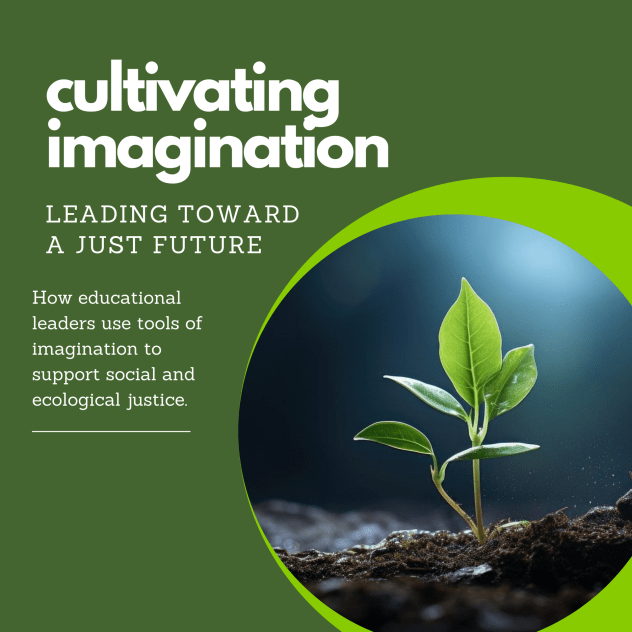By Lori Driussi, independent education consultant and Faculty Associate at Simon Fraser University
This blog is an extension of Episode 7 of the Cultivating Imagination podcast.
Imagination is a way of being, a door opener, an invitation for all to enter and contribute to the world we seek but have not yet realized. One might say the same of education. To move from performative to transformative teaching and leading we need to imagine. Imagine education as an endeavour to create a more just world. Imagine that a relational and radical acceptance is our priority and context for policy making.
We talk about serving all learners. This is a monumental task especially when we are still philosophically grappling with long-held structures, like evaluation practices and time tables. When that is at the forefront, it can feel overwhelming to take up imaginative ways of morphing an age-old institution. We have a long way to go to serve everyone equitably within the current structures and the added challenge of numerous invested stakeholders. With a system that is successful according to accepted markers (e.g. PISA – www.oecd.org/pisa) it seems foolish to change it too much. Moving from good to great is a genuine hurdle.
However, climate change, oppressed communities, and warring countries are in the headlines every day. We are in a bad way. This is causing large institutions, like education, to grapple with social justice concerns. Organizations are considering what it means to celebrate diversity and engage in equitable and inclusive practices. What does our teaching and leadership population look like? Who is represented? Who is not? How are our teaching and assessment practices sensitive to a range of world views? How might we humanize our policies? What actions will we take to make real and effective changes? This is where the powerful imaginative tool called “what if-ing” comes into play!
Sometimes we tell ourselves a story about what being a teacher or leader looks like and then we perform those roles. When we question these preconceived notions, we discover that what we think we have to do, we actually don’t! We can imagine something different, something more just. These conversations help us see the hard lines as less hard, maybe a bit dotted, with some space for curvature.
Professional development for our beginning and experienced teachers and leaders, offering ways to be better at our craft – think imaginatively! – is equally as important as technical and content knowledge. We know that cultivating opportunities for reflection, collaboration, and creating safe spaces for dialogue supports teachers and leaders in moving toward transformative practitioners. We need communities of support and dialogue to consider new ways to take the courageous steps necessary to make changes in the face of resistance.
In addition, I believe it’s in the moments in front of us that real change occurs. When we look at our students and colleagues as tangled knots of experiences and stories and understand that we all see the water in which we swim – our own perspectives – we open our imaginations. When we understand we are in a constant state of becoming, we might be more inclined to ask: what is your story? What might we learn about each other that will enhance and serve our community?
Here’s an example:
Kai (pseudonym) is waiting to be picked up from school so he came into my office to wait while I worked. As he flipped pages in a book about boats he began talking about his family’s fishing boat on Vancouver Island. Struggling to listen and answer the long list of emails at the same time, I chose Kai. His face was animated as he described in great detail the fish they catch, how they clean and prepare them for smoking, what bait is best, the time of year and the way the water and light look when the fishing will be good. In the 2 hours we waited for Kai to be picked up we built an entirely new relationship. I saw the fullness of his life beyond school and gained an appreciation for the way he learns. I saw how much knowledge (cultural, systemic and specific) he holds about his community that may never have come up otherwise. His teacher and I spoke the next day and considered ways to incorporate Kai’s way of learning and showing his learning within a classroom context that better matched his life on the land.
When we get outside and a student says, “fresh air clears my head. I can think now.” When we walk and talk to solve problems and a teacher says, “maybe I can be more like the trees, you know, a bit more bendy.” When we engage in difficult conversations and a participant says, “I never thought of that before. Your story has changed my behaviour.” We are always in a state of becoming in relation with the human and more than human world. Always in relation. This state of becoming is ripe with possibility, fodder for creating a better world at every turn.
Imaginative thinking, Dr. Egan’s tools (Teacher Resource: Cognitive Tools), give us tools to help us recognize when we are engaged in imaginative thinking and guidance for intentional ways to incorporate them into all aspects of teaching, learning and leading. Get together with some colleagues and explore!
Hear more from our leaders in the Cultivating Imagination podcast series.



